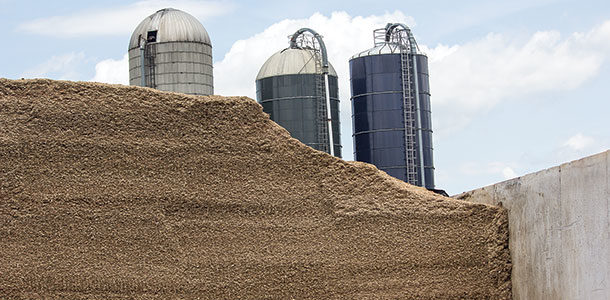Since mycotoxins were first identified in the 1960s, there has been an increased focus on contaminated feed due to global trading, increased monitoring and technology, changing agricultural practices, unexpected weather, food safety regulations and mycotoxin interactions.
Today, forage quality is a top priority on dairies as producers now recognize the risk poor feed ingredients can pose to the health and performance of lactating dairy cows.
Reductions in milk yield and rising somatic cell count (SCC) numbers may not be observable on a daily basis, but producers will notice the difference in production at the milk tank.
Many times it is not an acute case that can be readily identified but a chronic situation associated with the ingestion of a low level of mycotoxins over an extended period of time. This results in a wide array of subclinical symptoms that slowly reduce performance, eat away at the producer’s bottom line and compromise animal health.
 This bucket image shows an area from the bucket facing straight on, which caused lift on the pile and thus oxygen penetration. This can lead to aerobic instability issues, which may mean yeast, molds, bacteria and overall spoilage and dry matter loss that can be seen in the image as the more red/yellow coloration pocket in the middle. The bucket-facing pockets can last days to weeks from oxygen penetration and could extend into the rest of the pile in each area, with the potential for mold and yeast spoilage issues.
This bucket image shows an area from the bucket facing straight on, which caused lift on the pile and thus oxygen penetration. This can lead to aerobic instability issues, which may mean yeast, molds, bacteria and overall spoilage and dry matter loss that can be seen in the image as the more red/yellow coloration pocket in the middle. The bucket-facing pockets can last days to weeks from oxygen penetration and could extend into the rest of the pile in each area, with the potential for mold and yeast spoilage issues.
Mycotoxicosis in dairy cattle is often the result of exposure to multiple mycotoxins, due to pre-harvest infestation of feed materials by fusarium species, as well as from post-harvest contamination of stored or ensiled materials by penicillium and aspergillus species.
After examining more than 90 peer-reviewed papers on the cost implications mycotoxins can have at a similar risk level, it was calculated that cows may produce 3.5 pounds (1.6 L) of milk per day less when consuming mycotoxins. Additionally, milk somatic cell count (SCC) was shown to increase by 39 percent. With this loss of performance, the reduction in profitability per cow is an estimated decrease of $1.54 per day.
How do individual mycotoxin species affect herds?
- Zearalenone – embryo mortality, cystic ovaries and prolapsed vulva
- Aflatoxin – reduced milk production, liver damage and discarded milk
- Fusaric acid – lower leg swelling, feed refusal and lethargy
- T-2 toxin – gastroenteritis, intestinal hemorrhage, bloody feces, immune suppression and higher SCC
- Patulin, PR toxin, roquefortine C (penicillium toxins) – reduced feed intake and decreased milk production
- DON – reduced feed intake and decreased milk production
In the past, there has been limited risk analysis and assessment to enable dairies to deal proactively, rather than reactively, with mycotoxin contamination.
Today, using an improved liquid chromatography/mass spectrometry method, researchers can analyze for multiple mycotoxin contaminations in a given feed sample. The program provides a risk assessment and calculates the risk equivalent quantity (risk factor multiplied by the quantity of mycotoxins) for that particular feedstuff sample.
 The rake, when used by the right operator, can make a nice smooth face, but if used to claw, chop down and pull away silage, it can create lift. Like bucket facing, it can cause more oxygen penetration, leading to spoilage and dry matter losses. The vertical tine marks on certain rakes may leave a slightly larger surface area and create small thermal cavities that will radiate heat from the inner areas of the pile and allow slightly more oxygen penetration but not nearly as much as the bucket.
The rake, when used by the right operator, can make a nice smooth face, but if used to claw, chop down and pull away silage, it can create lift. Like bucket facing, it can cause more oxygen penetration, leading to spoilage and dry matter losses. The vertical tine marks on certain rakes may leave a slightly larger surface area and create small thermal cavities that will radiate heat from the inner areas of the pile and allow slightly more oxygen penetration but not nearly as much as the bucket.
The crop condition at harvest and the storage environment (temperature, oxygen, moisture) will determine if these levels rise during storage and increase the risk to cows.
Over the past two years, stored forages have increased in risk over the feeding year, and this risk needs to be monitored. Producers need to keep in mind the risk from mycotoxins is a moving target and what you feed today is not necessarily what you will feed tomorrow.
Every producer should consider adding a comprehensive and integrated mycotoxin management program to the operation, and that program should start in the field. Healthy plants protect themselves from fungal attack. Fewer fungal attacks mean fewer mycotoxins.
Some tips for controlling field mycotoxins:
- Apply fungicides at the proper time
- Rotate crops
- Avoid “no-till”
- Control weeds and insects
- Harvest at the proper time
It is also important to remember that some conditions cannot be controlled. Corn that is stressed and damaged by weather events and insects is more susceptible to mycotoxins. Cool, wet weather can be a precursor for mold growth and can lead to possible mycotoxin issues.
For example, Fusarium graminareum can produce a variety of mycotoxins and prefers high moisture and temperatures from 59 to 85ºF. While walking fields and looking for signs of molds, ear rot and stalk rot can be indicators for mycotoxins; however, there can be toxins present with no visible mold.
 The mechanical defacer is the best option and shows a cool consistent coloration across the face when used in a controlled downward motion. The mechanical defacers do not cause any lift and keep the face of bunkers and piles nice and smooth. Photos courtesy of Nick Adams.
The mechanical defacer is the best option and shows a cool consistent coloration across the face when used in a controlled downward motion. The mechanical defacers do not cause any lift and keep the face of bunkers and piles nice and smooth. Photos courtesy of Nick Adams.
After harvest, producers still need to manage the risk for potential mycotoxins in their feeds and forages. Feeding poor silage can be a high-loss situation.
Dry matter shrinkage in the silo, reductions in feed intake of 2 to 4 pounds per cow per day, zero daily gain and decreased immune status of the animal can all come into play when not producing and preserving good-quality silage on the farm.
Unfortunately, some producers still underestimate the preservation process needed to keep their forages an excellent source of nutrition for their herd. The following are critical control factors in producing high-quality feed:
- Cut forage at the ideal time to ensure maximum nutrients per acre. Don’t cut too low to the ground.
- Compact the bunker in both directions where possible, matching delivery rate to compacting rate.
- Seal the bunker quickly; the shorter the time to close the bunker, the better the quality as long as compaction targets are met.
- Practice good face management. When extracting silage, remove a minimum of 6 inches per day; more may be required in warmer weather. Work your way vertically from the top down of the silage face.
- Keep silage temperature zero to 5ºF within ambient range so there is not a problem with heating, whether that be from solar radiation or from yeast/mold activity.
- Remove spoiled and moldy silage to reduce the risk of mycotoxin contamination.
To achieve well-made silos, producers should aim for a packing density at a minimum of 15 pounds dry matter per cubic foot, 30 to 35 percent moisture, chop length at 1.3 to 2 centimeters and with limited oxygen exposure. Sealing the bunker is also very important. Silage must be wrapped properly to keep oxygen and water out, and there must be an anaerobic environment for the silage to ferment properly.
Management strategies that prevent exposure to and ingestion of mycotoxins are always the best course of action. When producers suspect mycotoxins are present, testing of feed samples should be the first action taken.
The main objective is to continually monitor the stored grain for temperature and moisture, to check for mold growth and analyze for mycotoxin production, prior to feeding the grain to livestock.
Be aware of the effects of multiple mycotoxins, implement a mycotoxin control program and stay vigilant with storage management. Good forage management at harvest, and after, ensures maximum return from a valuable feed source.













